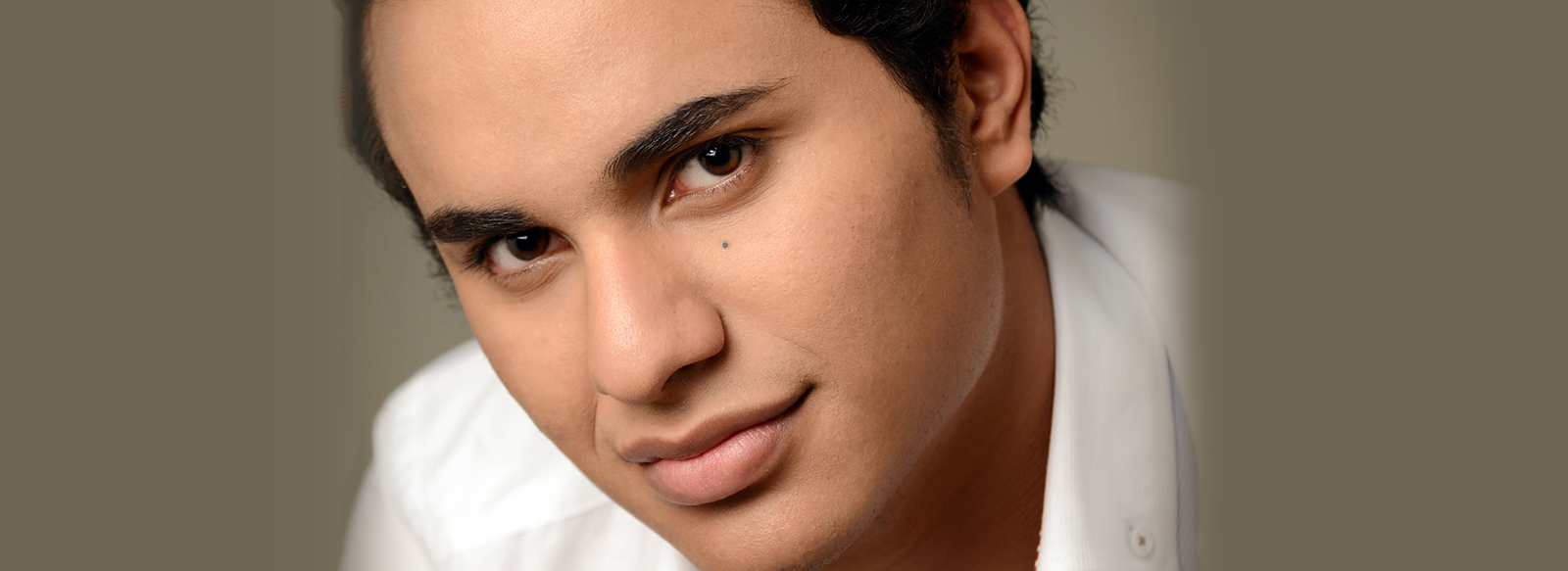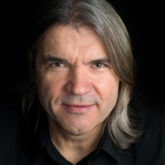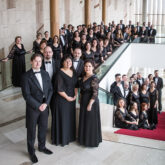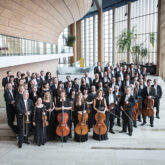Why did Bach, a devout Lutheran, write a Catholic Mass? What is more, why did he make it his one of his most elaborate and complex compositions, generally considered to be the pinnacle of his vocal works? The short answer is that he originally planned to present his work to the Catholic Saxon royal court, perhaps in hopes of employment. But this answer is unsatisfactory, since only parts of the work (the Kyrie and the Gloria) were used in this way, and Bach continued to work on the Mass almost to the end of his life, without any external, practical considerations.
Bach first composed a Sanctus movement for six-part chorus and orchestra; this was performed on Christmas Day, 1724, at St. Thomas’ Church in Leipzig. Contrary to later usage, the Lutheran Church in 18th-century Leipzig not only did not rule out singing in Latin, but actually required it, especially on major holidays. The polyphonic performance of all five movements of the Ordinary in Latin was to be found only in Catholic churches, but the Lutherans would often include one or two movements in their services. Bach wrote a total of five Sanctus settings over the years, all for his own use at St. Thomas’. The Ordinary movements most frequently performed in Lutheran Churches were, however, the Kyrie and the Gloria. In fact, these pairs were often simply called Missae (“Masses”); and Bach’s four short Masses (BWV 233-236), which consist only of Kyries and Glorias, were also intended for St. Thomas’.
Nine years after composing the D-major Sanctus (that ended up in the B-minor Mass), Bach composed the Missa (that is, a Kyrie and a Gloria) that later became part of the Mass in B minor. In the summer of 1733, he sent it off to the Elector of Saxony, Friedrich August II, accompanied by a letter in which he asked to be given the honorary title of Saxon Court Kapellmeister. (After a second application, his request was finally granted in 1736.) This was the second of only three major works Bach dedicated to a patron outside his city of residence: in 1721 he had given his Brandenburg Concertos to Christian Ludwig, Margrave of Brandenburg; and in 1747, he would present his Musical Offering to King Frederick II of Prussia.
We have no evidence of a performance of the Missa at the electoral court in Dresden. But the work has some unique characteristics suggesting that Bach was writing with a Dresden performance in mind.
Dresden, the capital of Saxony, boasted a music life far more active than that of Leipzig. First of all, it had an opera house with excellent singers from Italy. Bach visited Dresden several times, most recently in 1731, two years before submitting his Mass, when he almost certainly visited the opera (he saw Cleofide by Johann Adolf Hasse) and met with composers in the city.
Bach saw that his Dresden colleagues, many of whom were from Italy, were writing polyphonic Masses on a very grand scale. He felt inspired and challenged by this, as he was by the virtuosity of many singers and instrumentalists he heard in Dresden. One obvious sign of Dresden influence may be found in the bass aria, “Quoniam tu solus sanctus” from the Gloria of the B-minor Mass, which has a solo for corno da caccia (“hunting horn,” or the valveless natural horn of the 18th century). Bach rarely used the horn as a solo instrument and then exclusively in pairs: this is his only aria with one solo horn. Such horn writing was, however, frequent in Dresden at the time.
The enigmas start multiplying when we approach the remainder of the Mass. Until recently, the date of composition for the Credo, Osanna, Benedictus and Agnus Dei was a matter of conjecture. It was a Japanese musicologist, Yoshitake Kobayashi, who showed, in 1988, that these movements were not written until 1748-49 and are therefore the last music Bach ever wrote, postdating The Art of Fugue.
We still don’t know for sure why Bach decided to expand his earlier Ordinary movements into a full-fledged, and now unequivocally Catholic, Mass composition (a Missa tota, as the five-movement cycle was often referred to at the time). A number of hypotheses have been put forth about possible performance venues in Dresden. It seems likely that Bach wanted to create a “multi-purpose” work that could be performed in its entirety in a Catholic setting, or partially in a Protestant venue. His unusual division of the work seems to support this hypothesis: in a Catholic Mass the “Sanctus” would be immediately followed by the “Osanna,” but Bach drew a line between the two, joining the “Osanna” to the “Benedictus” and “Agnus” instead. This suggests that he wanted to keep the “Sanctus” a self-contained movement, appropriate for a Lutheran service.
One of the most striking characteristics of Bach’s compositional procedure in the B-minor Mass is his reliance on earlier compositions. This procedure is known in musicology as “parodying” (of course; no humoristic overtones are intended), and it may involve anything from literal repeat to extensive editing and recomposing. About half the movements in the B-minor Mass have been shown to derive from earlier compositions, and scholars suspect that the same is true even when the originals are not known. In the words of American musicologist George Stauffer, working on the Mass gave the composer “a final chance to rework and refine his earlier sources” and resulted in “a highly select sampling of vocal music culled from four decades of sacred and secular composition.” Some earlier writers have frowned upon such extensive self-borrowing, but it was clearly much more than a matter of convenience. The ingenious reworking of earlier compositions became a method that allowed Bach to graft new ideas onto old ones; it became an art of “super-variation” stretching from work to work across the years.
***
The Kyrie eleison begins with a four-measure choral invocation followed by an instrumental introduction and a tortuously chromatic, five-part choral fugue. The Christe eleison is a more light-hearted duet for two sopranos. The second Kyrie, in four parts,is not a repeat of the first but completely different music, written in an archaic style reminiscent of the stile antico still very much in use among church composers. Yet this style, rooted in the 16th-century works of Palestrina, received an “overlay” of chromaticism from Bach.
Appropriately enough, the Gloria brings in trumpets and kettledrums in a jubilant opening chorus, followed by a second choral movement, the magnificently polyphonic Et in terra pax. The soprano aria Laudamus te, with solo violin, demands a great deal of virtuosity from both the vocal and the instrumental soloists. The relatively low range of the vocal part makes it likely that it was written with the voice of mezzo-soprano Faustina Bordoni in mind. Bordoni was one of the stars of the Dresden opera (and was married to composer Johann Adolf Hasse). Also, Stauffer notes that a certain short-long rhythmic figure, prominent in this aria, was “highly fashionable in Dresden circles.” The four-part chorus Gratias agimus tibi is another stile antico piece, rigorously contrapuntal and with instrumental lines merely doubling the voices, as in the second Kyrie. With Domine Deus, for soprano and tenor solos and flute obligato, we are back to the conrtemporary world of Dresden. The style of the music resembles that of an operatic love duet. The two singers sing different texts simultaneously: the tenor has the words about the Father, the soprano those about the Son. In the opinion of the 19th-century scholar Philipp Spitta, Bach superimposed the two lines to express the “mysterious Unity of the Father and Son.” In the chorus Qui tollis, an extensive reworking of the opening chorus of Cantata 46 (1723), imitative passages alternate with homophonic ones (where all voices sing together in the same rhythm). The voices are accompanied by the florid lines of the two flutes. With Qui sedes, an aria for alto with oboe d’amore solo, another style makes its appearance in the Mass, namely dance music. Some writers have interpreted this movement as deriving from the gigue, others from the polonaise. It is probably neither, yet there is no question that this music comes from the same source of inspiration as Bach’s instrumental suites. Quoniam tu solus sanctus has already been mentioned as a special case among Bach’s arias, on account of the single corno da caccia, to which Bach further added two virtuosic bassoon parts. The Gloria ends with a jubilant chorus, Cum Sancto Spiritu that, with its trumpets and kettledrums, returns to the mood of the two opening choruses of this section. It combines the solemnity of the “Gloria in excelsis” with the contrapuntal agility of “Et in terra pax.” The elaborate conclusion reminds us of the fact that in its 1733 version, the work ended here.
Bach called the Credo portion of the mass Symbolum Nicenum, after Nicaea, the town in the Byzantine Empire (in what is now Northwestern Turkey) where the Nicene Creed was adopted by a council of bishops in the year 325. This is the most abstract part of the Mass text which has traditionally proven to be the most problematic for composers. Moreover, it was a text that Bach had never tackled until the last years of his life (some sketches probably dating from 1747 are the earliest signs of direct involvement). He approached the formidable task armed with the same multiplicity of styles already seen in the Gloria (stile antico alternating with styles derived from his Leipzig cantatas and, occasionally, from Dresden models). Like the Gloria, the Credo opens with a pair of choruses in contrasted styles: Credo in unum Deumis a further, densely contrapuntal, example of the stile antico (here in five parts and an instrumental “walking bass line” added to the voices); Patrem omipotentem is a four-part chorus in a more modern style, reminiscent of Bach’s Leipzig cantatas (it is, in fact, based on the opening movement of Cantata 171 from 1729). Et in unum Dominum Jesum Christum is a duet for soprano and alto (with two oboes d’amore as instrumental soloists) which continues the association between Jesus and an intimate aria style already seen in the “Christe” portion of the Kyrie and the “Domine Deus” movement of the Gloria. By its dark mood, the chorus Et incarnatus est stresses the inevitable connections between Christ’s incarnation and the Crucifixion, which follows immediately. The Crucifixus is the reworking of a much earlier work: the opening chorus of Cantata 12 (“Weinen, Klagen”). This cantata, written in Weimar in 1714, later inspired Franz Liszt to write one of his great organ works. It is one of the emotional high points of the entire composition. The chromatically descending bass, something of a Baroque cliché, was never invested with more passion – and the pun is intended, for never was Christ’s Passion expressed with more power than it was here. The jubilant trumpets and kettledrums of Et resurrexit form a most dramatic contrast; we are back to the radiant world of the Gloria. The resemblance between this movement and the “Réjouissance” from the Orchestral Suite No.4 has been pointed out by at least one commentator. The vocal line of the bass aria Et in Spiritum sanctum, accompanied by two oboes d’amore, contains the line about the “holy, Catholic and apostolic church” which most composers have found the most abstract and the least conducive to musical setting; Bach literally skates over what would otherwise be a problematic spot by the gently lilting rhythms of a pastoral dance, which turn an abstract institutional dogma into something perfectly simple, natural and good.
onfiteor is a grave and solemn movement: as a stile antico chorus, it matches the tone of the “Credo in unum Deum” which opened the Symbolum Nicenum. This passage takes its full meaning only if considered from a theological point of view, which Bach must certainly have done: baptism, while it leads to eternal life, does so only through the individual’s death and resurrection. Hence the unexpected austerity of this strictly polyphonic movement, which leads into what is certainly the most harmonically daring passage to be found anywhere in Bach’s works. The first appearance of the words “Et exspecto resurrectionem mortuorum” portrays the unfathomable mystery of the resurrection, and the suffering that is an unavoidable precondition of it, by a harmonic progression that plumbs the depths of despair with a series of modulations that are absolutely unique in the Baroque era. At one point, the tonality reaches E-flat minor that, with its six flats, represents the nadir of the classical tonal system. The transition from there to the restatement of the same words, Et exspecto resurrectionem mortuorum, in a bright and glorious D major, can only be compared to the transition between the third and fourth movements of Beethoven’s Fifth Symphony.
The Sanctus, written in 1724 and revised in the 1740s, is in six parts. A solemn first half is followed by an exultant fugue, in a fast tempo, on the words “Pleni sunt coeli and terra.”
In the Osanna the chorus is divided into two half-choirs of four parts each. The music, with its bright D-major sonorities with trumpets and kettledrums, is reminiscent of the opening of the Gloria. The music comes from a secular cantata, written to celebrate the anniversary of the election of Friedrich August II in 1734 (Cantata 215). The Benedictus is a tenor aria where the obligato instrument is not specified in the manuscript. Earlier it was assumed that Bach intended a violin; more recently, it has been assumed that he meant a flute because the part does not go below D above middle C (a violin could go several notes lower, and it seems unlikely that Bach would not have wanted to make use of those extra notes). It is a lyrical and affectionate aria that is a perfect foil for the “Osanna” which subsequently returns in its entirety. The Agnus Dei, scored for alto solo and strings, is also a reworking of an earlier aria, with substantial changes. The mourning for Christ and a plea for mercy, inherent in the text, are expressed by intense chromatic melodies that always symbolize torment, here further amplified by anguished melodic leaps and syncopated rhythms. Finally, the Dona nobis pacem chorus is entirely identical to “Gratias agimus tibi” from the Gloria. It may well be that Bach would have composed a different closing movement had his eyesight and his general health not begun to fail in 1749; but even as it stands, the movement is a convincing conclusion to the most grandiose of his works.










